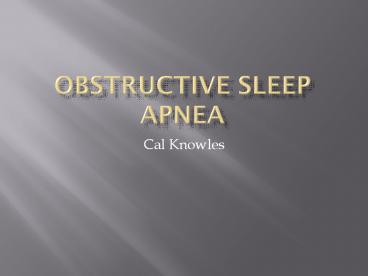Obstructive Sleep Apnea - PowerPoint PPT Presentation
Title:
Obstructive Sleep Apnea
Description:
Cal Knowles Obstructive Sleep Apnea (OSA) is a sleeping disorder that causes a person to stop breathing for a span of seconds In OSA, the airway narrows as the ... – PowerPoint PPT presentation
Number of Views:176
Avg rating:3.0/5.0
Title: Obstructive Sleep Apnea
1
Obstructive Sleep Apnea
- Cal Knowles
2
What is Obstructive Sleep Apnea?
- Obstructive Sleep Apnea (OSA) is a sleeping
disorder that causes a person to stop breathing
for a span of seconds - In OSA, the airway narrows as the muscles relax
during sleep, reducing the amount of oxygen in
the blood - Sleep apnea can lead to more severe health
problems like cardiovascular disease, high blood
pressure, diabetes, and/or a stroke
3
Information on OSA
- It is believed that 1 in 15 Americans (roughly 20
million) have sleep apnea - It is also believed that 80-90 percent of these
people are unaware that they have it - Symptoms are loud snoring, restless sleep, and
sleepiness during the day - Its more common in older people and those who
are obese and/or active smokers
4
Continuous positive airway pressure treatment
- The CPAP is a machine that is a common treatment
for those experiencing OSA - The CPAP is composed of a flow generator, a hose,
and an interface - The flow generator provides airflow, the
interface is a mask placed on the persons face,
and the hose connects the two
5
Pictures of a CPAP
6
How the CPAP treatment works
- The user is provided with a constant stream of
compressed air - The pressure from the air keeps the airway open
lessening/preventing the number of sleep apnea
episodes - It is the pressure, not the actual airflow that
forces the airway to stay open - The air pressure is measured in cm per water, and
most patients use a range from 6 to 14 cm per
water
7
Disadvantages to the CPAP
- Many are reluctant to try this method at first
due to the inconvenience of the mask, hose, and
machine - The air pressure also causes some patients to
experience nasal congestion or a runny nose, and
it may take a few weeks to adjust to the machine - The disadvantages are mainly because of comfort
reasons, and there are really no serious side
effects
8
Other methods of treatment
- About half of those diagnosed with OSA decide to
use the CPAP machine - One alternative is nasal surgery however, this
method has a very low success rate (under 10
percent) and is usually performed so the patient
can be fitted with a more convenient nasal mask
for the CPAP - Nasal ventilation has very little impact on sleep
apnea, and that is why it yields such low success
rates
9
Minimally invasive surgery for alternative
treatment
- Radiofrequency surgery uses high frequency
electrical currents and is applied to the soft
palate, the tongue, and or/the tonsils - All 6 of the subjects for this method saw an
improved score on their Epworth sleepiness scale
from pre surgery to post surgery - Soft palate implants is another method, where
cylinders of polyester yarn are inserted into the
soft palate - All 7 of these subjects had an improved score on
the Epworth sleepiness scale
10
Invasive surgery methods for alternative treatment
- The invasive surgery methods include pharyngeal
procedures (80 percent experienced improvement),
tongue base procedures (33), supraglottic
procedures (85), multi-level surgery (51.5),
maxillofacial surgery (90), tracheostomy (96)
11
Conclusion
- The findings were that the CPAP is the most
effective method due to its non-invasiveness and
lack of side effects - The minimally-invasive techniques as well as the
maxillofacial surgery were the next best methods
due to the efficiency of success compared to the
minimal amount of invasiveness - The tongue based surgery, as well as the
tracheotomy were both given the lowest rating for
effectiveness due to the low success rates for
the tongue based surgery, and the highly invasive
manner and rare necessity for the tracheotomy
12
Sources
- Maurer, Joachim. "Update on surgical treatment
for sleep apnoea" Swiss Medical Weekly 132
(2009) 624-629 - http//www.sleepapnea.org/
- http//www.nhlbi.nih.gov/health/dci/Diseases/Sleep
Apnea/SleepApnea_WhatIs.html - http//www.medicinenet.com/sleep_apnea/article.htm































